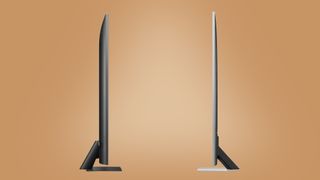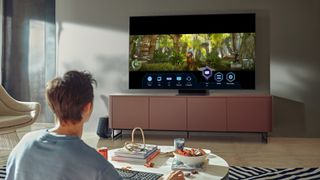Samsung Q80B vs Samsung QN85B: which mid-range QLED 4K TV is best?
Two new Samsung TVs, two (slightly) different technologies

If you're looking at the best Samsung TVs available in 2022, the question of the Samsung Q80B vs the Samsung QN85B will probably come up if you're looking for something with premium picture quality but still mid-range pricing.
Samsung’s 2022 range of TVs are almost all 4K, but after that your choice of screen technology is pretty wide – and there are significant differences just between the Samsung Q80B and QN85B, even though they're right next to each other in Samsung's range.
The Samsung Q80B features a QLED screen with a full array backlight, for example, while the QN85B features a Neo QLED panel with mini-LED technology – they work on the same principles, but the actual tech is absolutely not the same. The Neo QLED panel is more advanced – as we discussed in our full Samsung QN85B review – and the screen isn't the only thing that's different.
So how, really, are you meant to know which of these technologies is best for you?
Well, that’s where we come in. Here we’re going to compare and contrast the price differential, variations in specification and, basically, all of the relevant information in order to give you the best idea possible of how these models differ - and which one is more suitable for your needs.
Samsung Q80B vs Samsung QN85B: prices and sizes
As premium models, these TVs are both available in a number of different screen sizes, though they all tend towards the larger end of things. It’s important to choose the most appropriate size for your specific circumstances, of course – too small and you’ll immediately regret it, too big and you’ll never shake the feeling of being intimidated by your own television. If you’re a typical customer, this is a purchasing decision you’ll make once every six or seven years so getting the right size of screen (within your budget, of course) is crucial.
The Q80B is available in five screen sizes. The official prices are £999 / $999 for a 50-inch screen, £1,299 / $1,199 for the 55-inch model, £1,999 / $1,499 for the 65-inch version, £2,499 / $2,199 for the 75-inch screen, and £3,699 / $3,299 for the 85-inch model.
The QB85B, meanwhile, comes in four different sizes. It costs £1,399 / $1,299 for a 55-inch screen, £2,199 / $1,799 for a 65-inch model, £3,299 / $2,299 for the 75-inch version, and £4,699 / $3,299 for the 85-inch screen.
We're already seeing discounts on these TVs, so keep your eye on our price checkers for great deals.
There’s a size to suit quite a few different customers here and American customers can make a choice based almost entirely on performance, given the minimal price differential in their particular market. British customers, by way of contrast, will have to keep budget uppermost in their minds (and should at some point demand some answers from Samsung as to why they are, relatively speaking, being fleeced).

Samsung Q80B vs Samsung QN85B: Screen and design
There are some similarities between these two models, of course – they both have very minimal bezels, for example, which means they’re basically all screen when viewed from dead ahead. Both stand on a central pedestal, so if they’re not being wall-mounted they don’t need an especially wide surface to stand on. But there are more distinct points of difference between these two models than similarities, where both features and design are concerned, and they’re all worthy of consideration.
As far as design goes, the Q80B is 54mm deep – which may not seem a lot when written down but makes it one of the less flat flatscreens around. This relative bulk is the result of the 4K QLED panel’s full array backlighting: there are regular-sized LEDs across the entirety of the rear of the panel to provide the light the panel needs. That’s the downside to full array backlighting compared to cheaper edge-lit TVs (such as the Samsung BU8500); the upside is both the precision of the backlighting itself and the number of individual dimming ‘zones’ that are achievable.
The QN85B is a Neo QLED design – which is Samsung-speak for ‘mini-LED’. As the name strongly implies, a mini-LED panel uses much smaller LEDs to provide backlighting – around 40 times smaller than the LEDs the Q80B uses, in fact – and many more of them. This means you get even smaller and more numerous dimming zones, which in turn means the backlighting can be controlled down to a very fine level indeed. And it allows the QN85B to be a much more enticing 27mm deep despite offering better picture quality.
The Q80B uses Samsung’s AI Quantum Processor 4K to run the overall show. The AI Quantum Processor 4K allows for a degree of intelligence, meaning it can detect the type of content you’re watching and adjust its picture settings accordingly. It’s also accomplished where upscaling of sub-4K content is concerned, and uses some machine learning to attempt to bring greater three-dimensionality to on-screen images.
The QN85B is fitted with the higher-end Neo Quantum Processor 4K to govern its performance. Naturally it’s tuned to deal with the QN85B’s more complex backlighting array, but in every other respect it’s very similar indeed to the Q80B’s processing engine.

Samsung Q80B vs Samsung QN85B: Audio
As far as audio performance is concerned, the Q80B is fitted with six speaker drivers, two of which face upwards in an effort to provide a discernible ‘height’ element to sound when the TV receives a Dolby Atmos audio signal. An all-in total of 40 watts powers the speaker array. The Q80B features Samsung’s ‘Object Tracking Lite’ processing too, which endeavours to have the sound follow on-screen movement. And it’s compatible with ‘Q Symphony’, which means that if it’s partnered with an appropriate Samsung soundbar, the screen’s speakers remain active rather than being overridden. The Q80B is also able to assess the acoustic properties of the room it’s in and adjust its audio output to suit.
One of the downsides of a chassis as skinny as that of the QN85B is the relative lack of space in which to fit a meaningful audio system. Nevertheless, Samsung has squeezed in six drivers in a ‘2.2.2’ arrangement – which, like the Q80B, means a couple of upward-firing Dolby Atmos-friendly drivers. The slightly more assertive ‘Object Tracking’ algorithm is deployed here, and there’s a slightly more assertive 60 watts of power to drive the speaker array. There’s the same ‘Q Symphony’ compatibility as its more affordable sibling is present here, too. So the overall sound tech is very similar, but slightly higher-end in the QN85B.
There are further similarities. Both models share the Tizen-based smart TV interface Samsung has been refining for years and which is one of the best of its kind around when it comes to app and streaming support, though the latest version takes over the screen in a more annoying fashion than it used to.
Both models are compatible with HDR10+ Adaptive and HDR10+ Gaming HDR standards (although not Dolby Vision, because for reasons best known to itself Samsung simply isn’t interested). Both use Bluetooth 5.2 and Wi-Fi for wireless connectivity, and both have eARC capability.

Samsung Q80B vs Samsung QN85B: Gaming
Both of these models take the needs of gamers very seriously indeed. The Q80B supports HDMI 2.1 across all four of its HDMI 2.1 ports, including the 4K 120Hz compatibility, ALLM, HGiG and VRR (including Freesync Premium Pro) aspects of next-gen console specification too.
All of the QN85B’s quartet of HDMI inputs are 4K 120Hz-ready too, and with VRR, ALLM, Freesync Premium Pro compatibility on board there’s plenty to entice the next-gen gamer here too.
Both include Samsung’s bespoke Game Motion Plus, Super Ultra Wide Game View and Dynamic Black EQ features.
Samsung Q80B vs Samsung QN85B: Conclusion
Get beyond the panel technologies and the chassis dimensions that (partially) result from them, and there’s not a huge amount to choose between these two models – not on paper, anyway. The QN85B’s mini-LED configuration is geared for more precisely targeted backlighting, which means wider contrasts and deeper, more detailed dark tones. And it makes for a much slimmer screen, too, which might well be enough to swing it for you.
Or, at least, it might if you’re making this purchase in the United States – because the price differential between the two models is negligible in this area. For British consumers, there’s a far greater distance between the price of the Q80B and the equivalent QN85B – so in that case, you may prefer to save the cash, since the Q80B's is already very impressive. And the smaller size option may be welcome too.
Both rank among the best gaming TVs around thanks to their complete HDMI 2.1 support, and both are good value when compared to the best 4K TVs generally. It may just come down to your budget.
Get daily insight, inspiration and deals in your inbox
Get the hottest deals available in your inbox plus news, reviews, opinion, analysis and more from the TechRadar team.
Simon Lucas is a senior editorial professional with deep experience of print/digital publishing and the consumer electronics landscape. Based in Brighton, Simon worked at TechRadar's sister site What HiFi? for a number of years, as both a features editor and a digital editor, before embarking on a career in freelance consultancy, content creation, and journalism for some of the biggest brands and publications in the world.
With enormous expertise in all things home entertainment, Simon reviews everything from turntables to soundbars for TechRadar, and also likes to dip his toes into longform features and buying guides. His bylines include GQ, The Guardian, Hi-Fi+, Metro, The Observer, Pocket Lint, Shortlist, Stuff T3, Tom's Guide, Trusted Reviews, and more.

